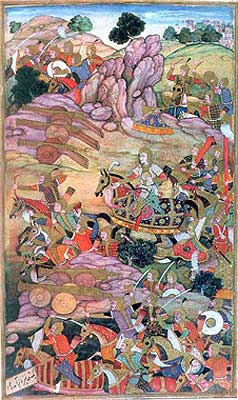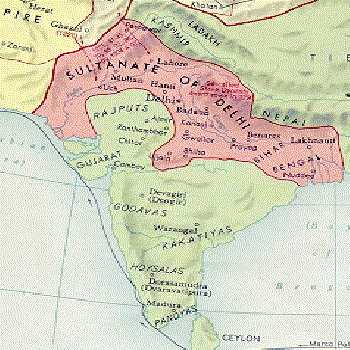
|
|
|
|
The Mughal Influence on Vaisnavism, Part 2 BY: SUN STAFF

Battle of Panipat Apr 07, CANADA (SUN) — A serial presentation of the Mughal effect on Vaisnava society. By way of further introduction of this series on the Mughal influence, we offer this brief overview of the conquerors who preceded the Mughals' intrusion into northern India. They were the Sultans of Turkey, who had overpowered much of northern India in the 13th century. The Turkish cavalrymen who invaded found several distinctly different levels of society in Bengal, from the northwestern and western regions which had already come under the Indo-Aryan and Hindu (post-Vedic) civilization, to the eastern delta, which was still the domain of various Brahmanic and Buddhist groups.
In the 10th century, for example, there was a one thousand square mile area in Sylhet (currently northeastern Bangladesh) that had been given over to eight Buddhist monasteries, and another six thousand Brahmans who co-existed with them on the land. Prior to that, in the 7th and 8th centuries, the Vedic culture in Bengal had undergone a significant change, with the re-infusion of Vedic civilization into regions that had come heavily under the Buddhist influence. In The Rise of Islam and the Bengal Frontier, R.M. Eaton describes this transformation, which saw Bengal's chieftains and rulers again patronizing Vaisnava temples, and building many new shrines for the deities. Many Brahmans were co-opted into this system, giving service to the mundane rulers who supported them rather than strictly following in the practices of their own sampradayas. "The regenerative cosmic sacrifice of Vedic religion, which Buddhists had already transformed into rites of gift-giving to monks, was now transformed into a new ceremony, that of the "Great Gift" (mahadana), which consisted of a king's honoring a patron god by installing an image of him in a monumental temple. These ideas crystallized toward the end of the eighth century, when, except for the Buddhist Palas, the major dynasties vying for supremacy over all of India—the Pratiharas of the north, the Rashtrakutas of the Deccan, and the Pandyas and Pallavas of the south—all established centralized state cults focusing on Hindu image worship. Instead of worshiping Vedic gods in a general or collective sense, each dynasty now patronized a single deity (usually Vishnu or siva), understood as that dynasty's cosmic overlord, whose earthly representative was the gift-giving king. These conceptions were physically expressed in monumental and elaborately carved temples that, like Buddhist stupas, were conceptually descended from the Vedic sacrificial fire altar. Brahmans, meanwhile, evolved into something much grander than domestic priests who merely tended to the life-cycle rituals of their non-Brahman patrons. Now, in addition to performing such services, they became integrated into the ritual life of Hindu courts, where they officiated at the kings' "Great Gift" and other state rituals." This was the environment into which the new conqueror's rode. The Turks of the Delhi Sultanate invaded Bengal to find a society in which the medieval kings were closely associated with the Brahmins. Asserting their Islamic conception, the Sultans found little welcome from the Hindus who, although generally very flexible in matters of religious practice, were not so flexible as to accept the Muslim religion. Prior to the Turk's arrival, the kings had engaged the brahmanas to perform all the royally sponsored rituals that served to uphold a semblance of Vaisnava dharma on behalf of society, and even though the Brahmanas had become politically compromised in their role, their service was nonetheless critical to the functioning of society. As the Sultanate attempted to insert itself into that milieu, the rift caused by Muslim interference was deeply felt and hard fought.

Map of Sultanate of Delhi in 1294 The transitions described above are well documented in the devotional arts of the day. During the 11th and 12th centuries, most of the art patronized by the Pala kings was Brahmanic in nature, with predominantly Vaishnava themes. This field of art is known as the Pala-Sena School. Court arts transformed into an entirely different mood under the Turks, however, as the Sultanate rulers eclipsed the transcendental personalities. The 17th century Mewari painting shown in yesterday's segment, of the Rajput king worshipping Sri Krsna, exemplifies how the focus eventually returned to the supremacy of God over emperor. During the Sultanate's era of rule, however, images of the deities were replaced with scenes of the Sultanate's opulent lifestyle, palace harems, hunting and war scenes. The rule of the Delhi Sultanate continued from the early 13th century until 1526, when they were attacked by Zahir al-Din Muhammad Babur, a fierce descendent of both Genghis Khan and Timur (Tamerlane). By 1525, Babur had captured the whole Punjab before proceeding towards Delhi. In the famous battle of Panipat, pictured above, Babur's army drove off the much larger Sultanate army. Babur's force of 15,000 men overpowered Sultan Ibrahim Lodhi's troops, which were 40,000 in number, accompanied by 100 war elephants. The attacking army's field artillery spooked the elephants, however, and they trampled their own men in a panic to escape the gunfire. Lodhi died at Panipat, and Babur established the Mughal ("Mongol") Empire, which ruled India until 1858, when the British colonial government took power.
| |